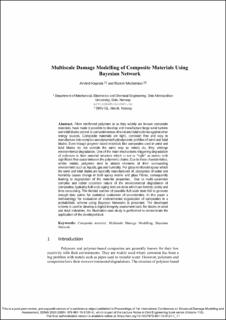| dc.contributor.author | Keprate, Arvind | |
| dc.contributor.author | Moslemian, Ramin | |
| dc.date.accessioned | 2021-01-28T10:28:52Z | |
| dc.date.accessioned | 2021-03-05T09:14:10Z | |
| dc.date.available | 2021-01-28T10:28:52Z | |
| dc.date.available | 2021-03-05T09:14:10Z | |
| dc.date.issued | 2020-12-13 | |
| dc.identifier.citation | Keprate A, Moslemian R. Multiscale Damage Modelling of Composite Materials Using Bayesian Network. Lecture Notes in Civil Engineering. 2020;110:135-150 | en |
| dc.identifier.isbn | 978-981-15-9120-4 | |
| dc.identifier.isbn | 978-981-15-9121-1 | |
| dc.identifier.issn | 2366-2557 | |
| dc.identifier.issn | 2366-2565 | |
| dc.identifier.uri | https://hdl.handle.net/10642/9877 | |
| dc.description.abstract | Fibre reinforced polymers or as they widely are known composite materials, have made it possible to develop and manufacture large wind turbine and tidal blades central to competitiveness of wind and tidal turbines against other energy sources. Composite materials are light, corrosion free and easy to manufacture into complex aerodynamic/hydrodynamic profiles of wind and tidal blades. Even though polymer-based materials like composites used in wind and tidal blades do not corrode the same way as metals do, they undergo environmental degradation. One of the main mechanisms triggering degradation of polymers is their material structure which is not as “tight” as metals with significant free space between the polymeric chains. Due to these characteristics, unlike metals, polymers tend to absorb elements of their surrounding environment such as liquids, gas and humidity. For glass reinforced epoxy which the wind and tidal blades are typically manufactured of, absorption of water and humidity causes change in both epoxy matrix and glass Fibres, consequently leading to degradation of the material properties. Due to multi-parameter complex and rather uncertain nature of the environmental degradation of composites, typically full-scale aging tests are done which are limited, costly and time consuming. The limited number of possible full-scale tests fail to generate enough data points for statistical evaluation of uncertainties. In this paper a methodology for evaluation of environmental degradation of composites in a probabilistic scheme using Bayesian Networks is presented. The developed scheme is used to develop a digital integrity assessment tools for blades in wind and tidal industries. An illustrative case study is performed to demonstrate the application of the developed tool. | en |
| dc.language.iso | en | en |
| dc.publisher | Springer | en |
| dc.relation.ispartof | Proceedings of 1st International Conference on Structural Damage Modelling and Assessment SDMA 2020 | |
| dc.relation.ispartofseries | Lecture Notes in Civil Engineering;Volume 110 | |
| dc.rights | This is a post-peer-review, pre-copyedit version of a conference object published in Proceedings of 1st International Conference on Structural Damage Modelling and Assessment, SDMA 2020 (ISBN: 978-981-15-9120-4), which is part of the Lecture Notes in Civil Engineering book series (Volume 110) | en |
| dc.subject | Composite materials | en |
| dc.subject | Multiscale damage modelling | en |
| dc.subject | Bayesian networks | en |
| dc.title | Multiscale Damage Modelling of Composite Materials Using Bayesian Network | en |
| dc.type | Conference object | |
| dc.date.updated | 2021-01-28T10:28:52Z | |
| dc.description.version | acceptedVersion | en |
| dc.identifier.doi | https://doi.org/10.1007/978-981-15-9121-1_11 | |
| dc.identifier.cristin | 1863302 | |
| dc.source.journal | Lecture Notes in Civil Engineering | |
